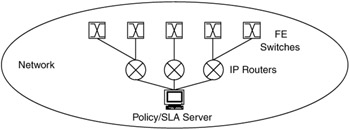8.8 Exercises
8.8 Exercises
For Exercises 1 through 6, refer to the performance requirements listed here.
-
Requirement 1: Two clearly different sets of network performance requirements— one high RMA and the other low RMA (for that network)
-
Requirement 2: A requirement to bill subscribers for network service and to provide accounting of subscriber billing information
-
Requirement 3: Combining a customer's voice and data traffic over a common network
-
For each performance requirement listed, explain why performance mechanisms are needed to support the requirement.
-
DiffServ and IntServ are two approaches to providing QoS in IP networks and are designed to support performance from different perspectives. For the requirements listed, which would you recommend: DiffServ, IntServ, both, or neither? Give reasons for your choices.
-
Which of the requirements indicates single-tier performance? Multitier performance?
-
Figure 8.5 shows the traffic conditioning functions: classification, marking, metering, shaping, and dropping. For Requirement 3 (combining voice and data traffic), outline how the process of traffic conditioning, using these five functions with DiffServ, would be applied to this requirement. Assign a DSCP to each traffic type.
-
Combining Requirements 2 and 3, write an SLA for this network and include sample pricing for Requirement 2. Use the following performance requirements:
-
Voice traffic must have an availability (RMA) of 99.999% (excluding scheduled maintenance times), measured everywhere in the network.
-
Data traffic must have an availability (RMA) of 99.99% (excluding scheduled maintenance times), measured between user devices and servers.
-
-
A performance architecture consists of QoS, SLA, and policy mechanisms, applied at network devices and servers, to support performance within the network (Figure 8.14). Given that there will be a policy and SLA database server and IP routers and Fast Ethernet switches with DiffServ QoS, outline how QoS, SLAs, and policies could be implemented to support the two sets of performance in Requirement 1.

Figure 8.14: Network for Exercise 6. -
List four types of problems that the performance architecture addresses. Give examples of each type of problem.
-
For each of the following queuing mechanisms, give an example of how each would be used within a network. What problem(s) is each mechanism solving?
-
FIFO
-
CBQ
-
WFQ
-
RED
-
WRED
-
EAN: 2147483647
Pages: 161